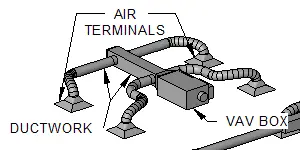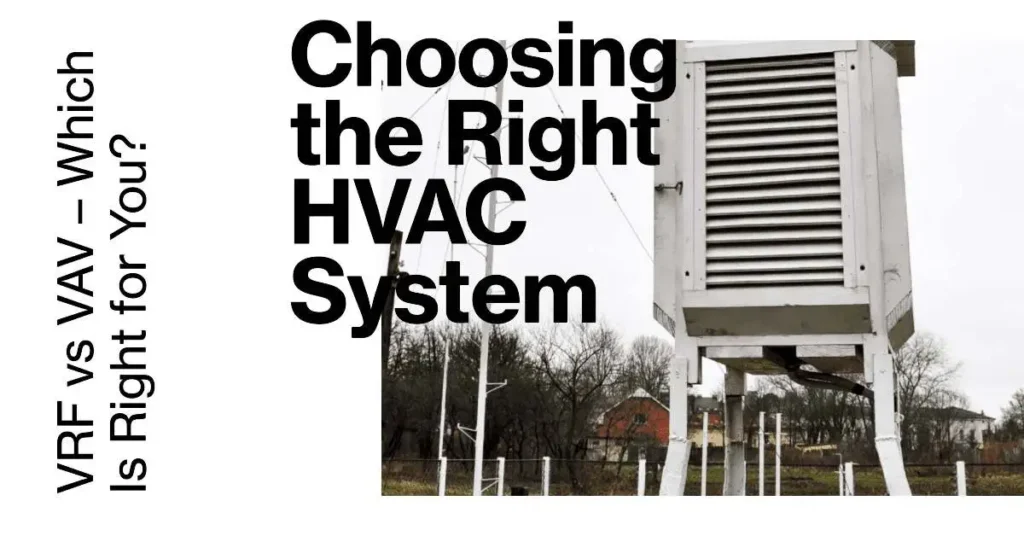Choosing the ideal HVAC system doesn’t have to be complicated. We’ll explore VRF vs VAV to find out which one offers the best way to keep your space comfortable and energy-efficient. No jargon, just a clear path to making the right choice for your indoor climate.
VRF and VAV. These systems are all about keeping spaces comfortable and energy-efficient.
What is VRF?

VRF System Overview
The VRF system, or Variable Refrigerant Flow, is a modern HVAC system. It works using a clever method. Instead of blowing hot or cold air into rooms, it uses a special liquid called refrigerant to control the temperature. This liquid flows through pipes to different zones, adjusting the temperature as needed. It’s like having a smart thermostat for each room.
Advantages of VRF Systems
VRF systems have some super cool benefits. First, they’re fantastic at saving energy. They only use what’s necessary to keep each room comfy, which is great for your wallet and the environment. Plus, they are masters of precise temperature control. You won’t be too hot or too cold with a VRF system.
Real-World Uses
VRF systems are all over the place. You can find them in hotels, offices, and big buildings. They’re perfect for places where you need individual control in different rooms. So, if you’ve ever been in a hotel room with a thermostat, there’s a good chance it’s using a VRF system.
What is VAV?

VAV System Overview
VAV, or Variable Air Volume, is another way to keep indoor spaces comfortable. It does this by managing how much air is sent to different areas. It’s like having vents in your house that can open or close depending on what’s needed.
Advantages of VAV Systems
VAV systems have their own set of cool features. They are very flexible. Think of them as being able to adjust like a dimmer switch for lights. You can change how much air each room gets. This can save you money because you only use what’s necessary. VAV systems are also cost-effective, which means they don’t break the bank.
Real-World Uses
You’ll find VAV systems in many places too. They are often used in offices, schools, and commercial buildings. Anywhere that needs efficient and flexible climate control will likely have a VAV system. So, if you’ve ever felt comfortable working in a big office building, it might be thanks to a VAV system.
VRF vs VAV – Which Is Right for You?

When it comes to selecting the right HVAC system for your space, understanding the differences between Variable Refrigerant Flow (VRF) and Variable Air Volume (VAV) systems is crucial. Let’s break down these two options in simple terms:
Energy Efficiency
- VRF: VRF systems are like energy-saving champs. They only use the exact amount of refrigerant needed to maintain the perfect temperature in each area, which helps in saving energy and money.
- VAV: VAV systems are energy-efficient too, but in a different way. They adjust the amount of air delivered based on the cooling or heating needs, making them efficient as well.
Temperature Control
- VRF: If you want precise climate control with minimal temperature fluctuations, VRF is the way to go. It ensures each room maintains the desired temperature without compromise.
- VAV: VAV systems are good at keeping spaces comfortable, but they may not provide the same level of precision as VRF systems.
Installation and Maintenance
- VRF: Installing VRF systems can be a bit more complex due to the refrigerant piping. Maintenance is crucial to ensure its efficiency, but modern VRF systems often come with advanced self-diagnostic features.
- VAV: VAV systems are simpler to install and maintain. They consist of less complex components, making them cost-effective in terms of installation and upkeep.
Cost Considerations
- VRF: While VRF systems may have a higher initial cost, their long-term energy savings can outweigh the initial investment. The precise control can lead to significant cost reductions over time.
- VAV: VAV systems are generally more budget-friendly upfront, but you may incur slightly higher operational costs due to less energy-efficient operation.
In the VRF vs VAV showdown, the choice depends on your specific needs, budget, and the level of control you require. Both systems have their strengths, and understanding these factors will help you make an informed decision.
When to Choose VRF
Practical Usage and Real-World Scenarios
VRF systems shine in large commercial spaces where different zones require distinct temperature control. They’re ideal for buildings with varying heating and cooling needs, such as hotels, shopping centers, and office complexes. VRF excels when there’s a need for individualized climate management.
Benefiting Industries and Building Types
The hospitality industry loves VRF for its ability to provide guest comfort in hotels. Retail businesses appreciate it for maintaining consistent temperatures in shopping malls. Large corporate offices also benefit from the zonal control that VRF offers, creating a pleasant working environment.
When to Choose VAV
Practical Usage and Real-World Scenarios
VAV systems are the go-to choice when you’re working with smaller to medium-sized spaces. They’re a better fit for schools, small offices, and residential buildings. VAV is efficient in areas where heating and cooling loads are more uniform and don’t require extreme precision.
Cost-Effectiveness
VAV systems are budget-friendly and an economical choice for projects where stringent zoning isn’t a priority. Their simple installation and maintenance make them attractive for smaller buildings or those with cost constraints.
Read Also: EER vs SEER: Your Guide to Smarter HVAC Choices
Key Takeaways:
- The choice between VRF and VAV depends on the size and specific needs of your project.
- VRF is best for large, complex spaces with varying requirements.
- VAV is cost-effective and suitable for simpler, smaller projects.
Additional Resources
- For more in-depth information on VRF and VAV, check out these resources:





